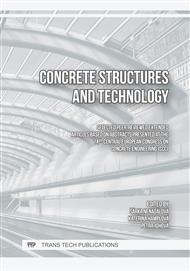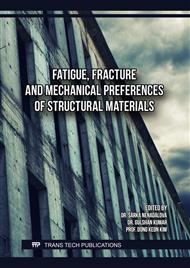[1]
S. Xing, Z. Xu, G. Jun, Inventory analysis of LCA on steel and concrete construction office buildings, Energy and Buildings. 40 (2008) 1188-1193.
DOI: 10.1016/j.enbuild.2007.10.016
Google Scholar
[2]
T. Ramesh, R. Prakash, K.K. Shukla, Life cycle energy analysis of buildings: An overview, Energy and Buildings. 42 (2010) 1592-1600.
DOI: 10.1016/j.enbuild.2010.05.007
Google Scholar
[3]
D.J.M. Flower, J.G. Sanjayan, Green house gas emissions due to concrete manufacture, The International Journal of Life Cycle Assessment. 12 (2007) 282-288.
DOI: 10.1007/s11367-007-0327-3
Google Scholar
[4]
A. Petek Gursel, E. Masanet, A. Horvath, A. Stadel, Life-cycle inventory analysis of concrete production: A crtical review, Cement and concrete Composites. 51 (2014) 38-48.
DOI: 10.1016/j.cemconcomp.2014.03.005
Google Scholar
[5]
Y. Dong, Performance assessment and design of ultra-high performance concrete (UHPC) structures incorporating life-cycle cost and environmental impacts, Construction and Building Materials. 167 (2018) 414-425.
DOI: 10.1016/j.conbuildmat.2018.02.037
Google Scholar
[6]
E. Fraile-Garcia, J. Ferreiro-Cabello, F.J.M. de Pison, A.V. Pernia-Espinoza, Effect of design and construction on the carbon footprint of reinforced concrete columns in residential buildings, Materiales de Construccion. 69 (2019) e193.
DOI: 10.3989/mc.2019.09918
Google Scholar
[7]
Information on https://tradingeconomics.com/european-union/construction-cost-idx-eurostat-data.html
Google Scholar
[8]
M. Turudic, M. Dragojevic, Estimated Value vs Final Contract Value in Works Public Procurement – What Causes the Discrepancy?, European Procurement & Public Private Partnership Law Review, 19 (2024) 14-21
DOI: 10.21552/epppl/2024/1/5
Google Scholar
[9]
Information on https://www.structuraltechnologies.com/blog/advantages-of-post-tensioning/
Google Scholar
[10]
D. Miller, J.-H. Doh, H. Guan, M. Mulvey, S. Fragomeni, S.T. McCarthy, T. Peters, Environmental impact assessment of post tensioned and reinforced concrete slab construction, Proceedings of the 22nd Australasian Conference on the Mechanics of Structures and Materials (ACMSM22), CRC Press. (2013) 1009-1014
DOI: 10.1201/b15320-180
Google Scholar
[11]
Information on http://www.bbr-adria.com/
Google Scholar
[12]
H. Süleymanoğlu, A. Uzel, G. Arslan, Use of Post-tensioned Concrete Slabs for Sustainable Design of Buildings. High Tech Concrete: Where Technology and Engineering Meet. Springer (2017) 2390-2395
DOI: 10.1007/978-3-319-59471-2_272
Google Scholar



